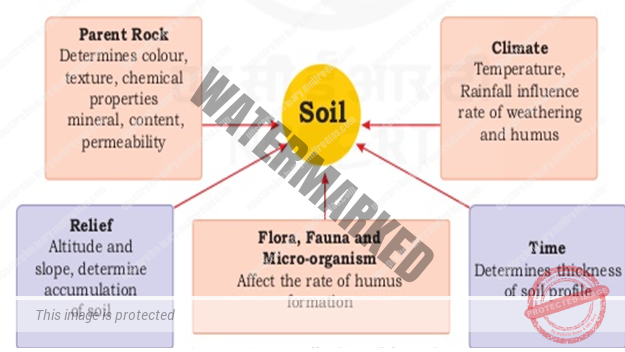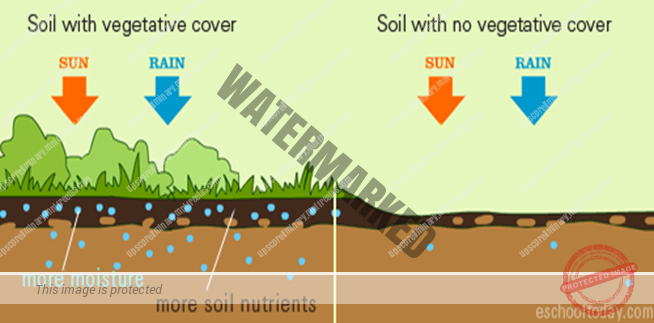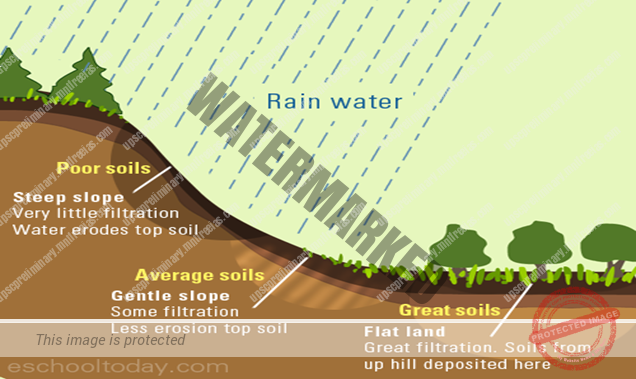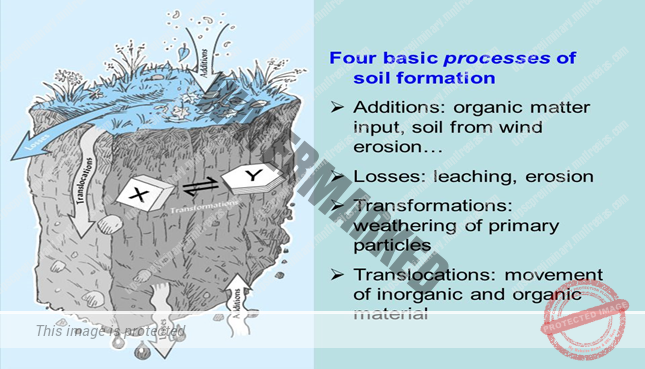- FACTORS RESPONSIBLE FOR SOIL FORMATION
- ROLE OF TEMPERATURE
- SOIL FORMATION – THE PEDOGENIC PROCESS
UNIT 5 – SOIL – PART 2
FACTORS RESPONSIBLE FOR SOIL FORMATION
The major factors affecting the formation of soil are Relief, Parent Material, Climate, Vegetation and other life-forms and time. Besides these, human activities also influence it to a large extent.
PARENT ROCK
The rocks from which soils are formed are called parent materials. In most of the cases, the parent material determines the colouration, mineral composition and texture of the soil.
The peninsular soils reflect the parent rock very much.
- The ancient crystalline and metamorphic rocks which are basically Granite, gneiss and schist form red soils on weathering because they contain iron oxide.
- Soils derived from Lava Rocks are black coloured.
- Sandy soils are derived from Sandstone.
CLIMATE
- The role of climate is to vary the inputs of heat and moisture. It affects the rate of weathering of the parent rock. Hot And Humid environments, in general, witness the most rapid weathering of parent materials.
ROLE OF PRECIPITATION: In areas that experience a lot of rainfall
water percolating down through soil tends to leach nutrients and organic matter out of the upper layers, unless modified by other soil components like plant roots.
- g., the soils underlying tropical rain forests tend to be nutrient-poor because of intensive leaching due to heavy rains; most of the nutrients are stored in the lush vegetation itself.
- Conversely, in arid regions with little annual precipitation, high rates of evaporation encourage the accumulation of salts in the soil.
ROLE OF TEMPERATURE:
Temperature increases the rate of reaction, such as chemical reactions, evapotranspiration and biological processes. Wide fluctuations in temperature, especially in the presence of water cause shrinking and swelling, frost action and general weathering in soils.
- g., Laterite soils are found in alternate wet and dry climate.
- In Rajasthan, both granite and sandstone give birth to sandy soil irrespective of parent rock because of high temperature and wind erosion.
BIOTA (FLORA, FAUNA AND MICROORGANISMS)
Biota, in conjunction with climate, modifies parent material to produce soil.
- The kind and amount of plants and animals that exist bring organic matter into the soil system as well as nutrient elements. This has a great effect on the kind of soil that will form.
E.g., Soils Formed Under Trees are greatly different from soils formed under grass even though other soil-forming factors are similar.
- The Roots of Plants also hold the soils and protect them from wind and water erosion. They shelter the soils from the sun and other environmental conditions, helping the soils to retain the needed moisture for chemical and biological reactions.
TOPOGRAPHY
(Relief, Altitude and Slope)
Topography is often considered a passive factor modifying the effects of climate.
- The relief is the most important factor for soil formation in places with steep slopes like the Hilly Regions, Edges of Plateaus
- Soil erosion on barren slopes is rampant and it hinders soil formation. Example: Chambal ravines, higher reaches of Himalayas where there is minimal or no forest cover (most on the steep southern slopes) etc.
- The areas of low relief or gentle slope generally experience deposition and have deep soils. Example: Indo-Gangetic plain.
TIME
Soils can take many years to form. Younger soils have some characteristics from their parent material, but as they age, the addition of organic matter, exposure to moisture and other environmental factors may change its features. With time, they settle and are buried deeper below the surface, taking time to transform. Eventually, they may change from one soil type to another.
SOIL FORMATION: THE PEDOGENIC PROCESSES
Conversion from rocks to soils happens via four basic processes:
ADDITIONS: Most additions occur at the surface. The most obvious ones include solar energy, water controlled by climate, and organic material derived principally from the vegetation.
LOSSES: Losses occur both from the surface and from the deep subsoil. For instance, water is lost by evapotranspiration and carbon dioxide by diffusion at the surface and, on a more catastrophic level, large masses of soil can be stripped by erosion.
TRANSLOCATION: It refers to the physical movement of material within the soil. The material can be in the solid, liquid or gaseous form, the movement can be in any direction from and to any horizon. For instance, clay, organic matter and iron and Aluminium Hydrous Oxides are commonly moved from the surface horizon to a subsurface horizon.
TRANSFORMATION: Transformations, involve the change of some soil constituent without any physical displacement. Chemical and physical weathering and the decomposition of organic matter are included here.




